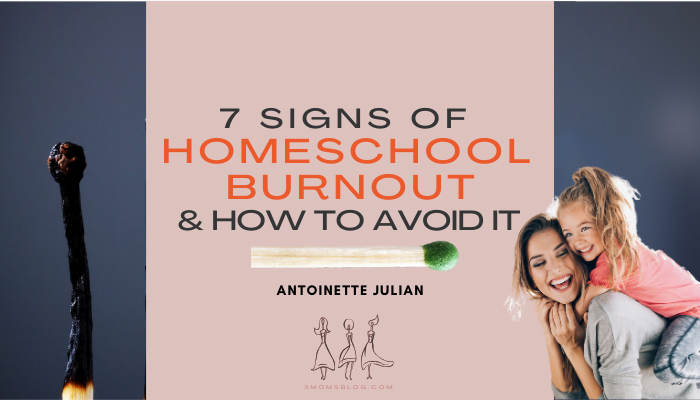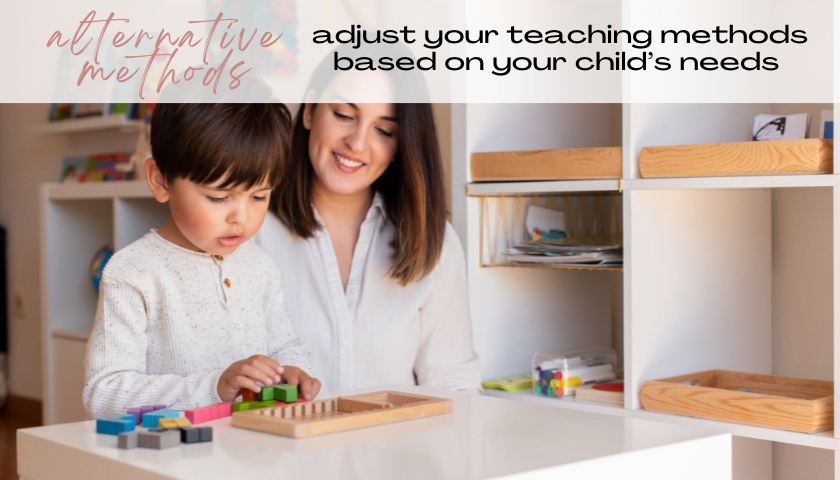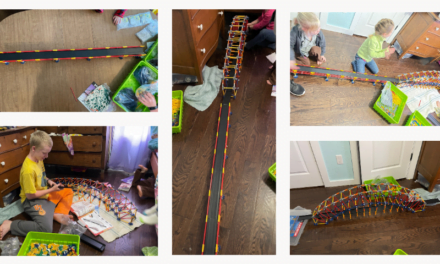First, homeschooling can be one of the most rewarding journeys for both parents and children. It offers flexibility, personalized learning, and deeper family connections—all amazing aspects. You know there is a “but” coming, don’t you? Yes, homeschooling can also come with challenges. And socialization is rarely one of them! One of the most common issues homeschooling families can face is homeschool burnout.
When we parents take on the responsibility of educating our child, we can experience homeschool burnout for myriad reasons: an illness, a new baby, added responsibility, a change in routine or economic circumstances, etc. You are not alone; life is full of the unexpected.

what are the symptoms of homeschool burnout?
When the responsibilities of teaching, parenting, AND managing the household become overwhelming, it’s easy to feel exhausted and discouraged. Children can experience homeschool burnout, just like school children can experience school burnout. The symptoms of burnout vary from lack of patience to overeating and irritability. Homeschool burnout is a wake-up call – an indicator that it is time to make adjustments somewhere. Recognizing the signs of homeschool burnout is vital for addressing it effectively and heading off negative outcomes.
common signs of homeschool burnout
- Physical or emotional exhaustion: Do you or your child feel tired and drained most of the time, even after getting enough rest? Physical symptoms may manifest as headaches, muscle tension, and frequent illnesses. Feeling overwhelmed, emotionally drained, and unable to cope with stress? This can also include mood swings, irritability, and a sense of hopelessness or cynicism.
- Negativity: Do you have a negative outlook or cynical attitude towards homeschooling, life, or others? You may become increasingly critical, seeing only the negative aspects of situations.
- Reduced performance: Have you noticed a decline in motivation and productivity in homeschooling or other areas of life? You may find it difficult to concentrate, make decisions, or complete tasks efficiently. Children may become reluctant to engage in lessons or lose interest in learning altogether.
- Sense of incompetence: Feeling like you’re not making a difference or achieving your goals despite your efforts? This can lead to self-doubt, low self-esteem, and a loss of motivation.
- Isolation: Do you find you are withdrawing from social interactions and activities you once enjoyed? You might feel disconnected from others and lose interest in maintaining relationships.
- Loss of interest and enthusiasm: Have you lost your passion and enthusiasm for homeschooling, hobbies, and other activities? You may no longer find pleasure in things that once brought you joy. Is your child resisting learning or refusing to participate in lessons or showing disinterest in educational activities. This can signify homeschool burnout and a need for a break from the traditional homeschooling routine.
- Physical warning signs: Chronic stress and burnout can manifest in physical symptoms such as fatigue, muscle tension, digestive problems, chest pain, rapid heartbeat, and shortness of breath.
strain on the parent-child relationship
All of these symptoms of burnout can cause strain on your parent-child relationship and conflict or tension in your interaction. We can become frustrated with our child’s lack of motivation or progress. Children can resent being pushed too hard or feeling like they’re under constant scrutiny. That is not what ANY of us signed up for when we chose to homeschool. How do we make it stop or avoid it altogether?
Hint: Montessori parenting and homeschooling techniques can help remedy all of these and are incorporated into these tips.
10 tips to fix or avoid homeschool burnout
It’s important to pay attention to these signs and take proactive steps to address homeschool burnout before it escalates. Here are strategies to prevent burnout or stop it in its tracks and ensure the fulfilling homeschool experience you initially envisioned.
1. lower your expectations
No, this is not simply the easy way out. Do not be a perfectionist. Perfectionism robs your life of joy. Modeling perfectionism for your child promotes a fixed mindset that can leave them dissatisfied with their efforts and fear of making mistakes.

2. try alternative methods
When something does not work, pivot and try other things. (PIVOT, PIVOT!) Stress hormones interfere with learning, making the processing, storage, and retrieval of information less effective. If tension starts mounting, take a break. Flexibility is a key factor.
When necessary, change the style of teaching. Be open to adjusting your teaching methods and strategies based on your child’s individual learning style and needs. What works for one child may not work for another, so be willing to experiment and tailor your approach accordingly. I was a kid who was happy with worksheets—as long as they were challenging. My kids did not learn that way, and I had to adjust. The multisensory learning in Montessori was a game-changer for us.
3. try role-playing
Occasionally switch roles with your child. Encourage them to teach you about something, ask you questions about your knowledge, and challenge you to try new things. For instance, small children love to talk about spelling when they quiz an adult.
4. avoid overscheduling
Personally, this is one behavior I struggled with in our early years of homeschooling. I had to remind myself to allow for white space (blank spots) on our calendar. Do not pack too many activities for the sake of socializing your child. A worn-out mom can lead to a grouchy kid and that can mean crankiness for all.

5. get support from your spouse, friend, or a support group
You do not have to do it on your own. Can someone in your life or a local class teach your child woodshop or home economics skills? Online homeschool communities are great, but it is one of the greatest helps to connect with a local homeschool group for fellowship, encouragement, advice, field trips, and other activities. Of course, keep in mind No. 4 above. Homeschooling can mean ‘happy schooling!
6. establish a realistic schedule
Cast off unrealistic expectations! Homeschooling does NOT need to mimic the traditional school environment with rigid schedules and long hours of lecture instruction. Allow plenty of time for independent, interest-led learning. I have a post coming about using index cards as a scheduling tool. This has helped many homeschool families that I counsel.
7. prioritize self-care
As a homeschooling parent, neglecting your needs is easy while focusing on your child’s education. However, prioritizing self-care is essential for your well-being. You cannot pour from an empty cup. Carve out time for yourself each day, even just a few minutes of quiet reflection or deep breathing. Find activities that help you relax and recharge: journaling, exercising, reading for pleasure, or pursuing a hobby. Maybe do that reading during a long, hot bath!
Adult coloring books have become popular as a self-care tool. We have created an inspirational quote coloring book that is great for kids and adults!

8. foster independence
Encourage your child to take ownership of their education and foster independence by involving them in setting goals, planning their schedule, and completing tasks independently. Provide self-directed learning projects. Montessori uses a 3-hour work period where your child can dive deep into activities of interest. Post coming on that too.
Teach your child valuable life skills, such as time management, organization, and problem-solving, which empower them to take responsibility for their learning.
Celebrate their successes and encourage them to appreciate the learning from setbacks. This fosters a growth mindset that values effort and resilience.
9. embrace flexibility
While structure and routine are important, it’s equally important to be adaptable and willing to go with the flow when unexpected challenges arise. Deviate from your lesson plan, take a spontaneous field trip when opportunities for learning pop up. Learning happens everywhere and isn’t confined to a set curriculum or schedule. Flexibility is key to maintaining sanity and preventing burnout in the homeschooling journey.
10. seek professional support
Finally, don’t hesitate to seek professional support if you’re overwhelmed or burned out. Whether consulting with a homeschool coach or therapist, they can provide valuable insights and strategies to help. A fresh perspective from someone outside your immediate circle can offer clarity and validation. These resources can help you navigate the challenges of homeschooling more effectively.
Remember, homeschooling can be a fulfilling and enriching experience. By following these tips, you can avoid burnout and create a more sustainable and enjoyable homeschooling experience for you and your family. Be kind to yourself, celebrate your successes, and stay connected to your reasons for choosing homeschooling in the first place. With patience, perseverance, and a healthy dose of self-care, you can thrive as a homeschool family.
I hope this helps you to gain a renewed sense of purpose and confidence in your homeschooling journey.

Antoinette
Check out my author page for more tips and encouragement.

4th of July Beekeeping Breastfeeding Budgeting Childhood Allergies Christmas Culture/Geography/History Doctor Visits Encouragement Food Allergies Free Montessori Printables Free Printables Funschooling Gardening Gluten-Free Grain-Free Home Management Homeschool Curriculum Homeschool for Free Homeschool Organization Homeschool Planning Homeschool Printables homeschool transcript Humor Infant Kids Birthdays Language Arts Meal Planning Montessori Home Montessori Homeschooling Montessori Parenting New to Homeschooling Pets Positive Parenting Practical Life Printable Planners Recipe Recipe Cards Science Summer The Thrifty Widow Toddler Unschooling Vegan Youth sports




